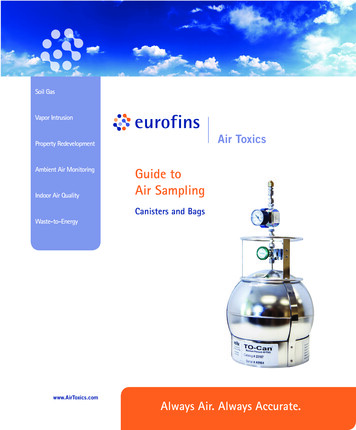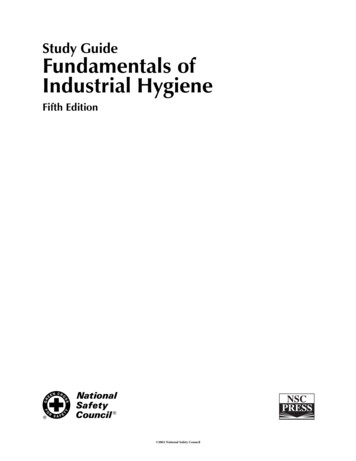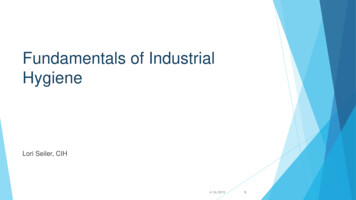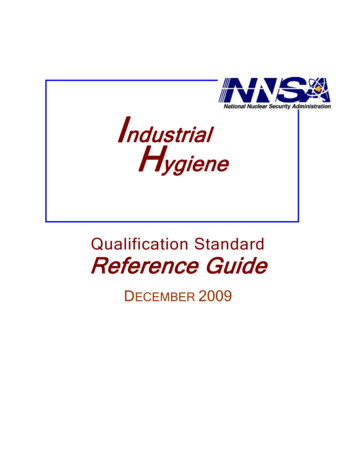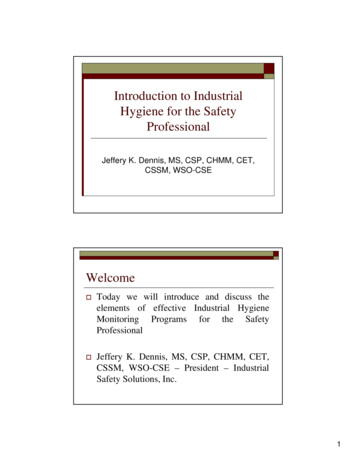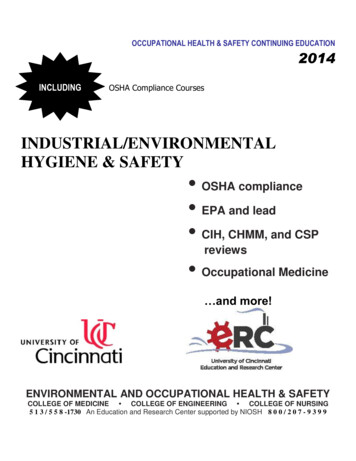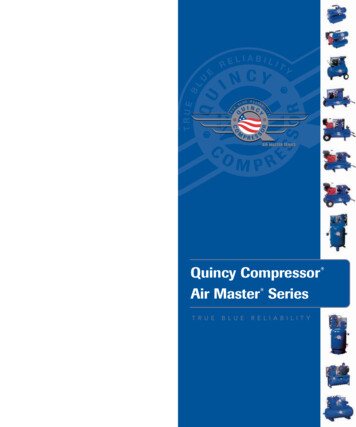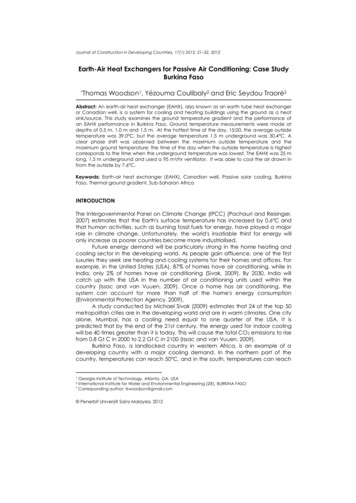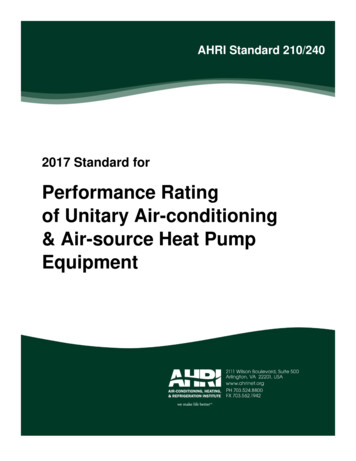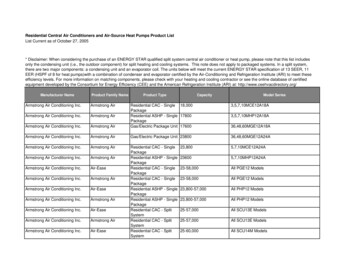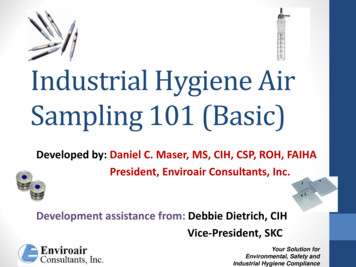
Transcription
Industrial Hygiene AirSampling 101 (Basic)Developed by: Daniel C. Maser, MS, CIH, CSP, ROH, FAIHAPresident, Enviroair Consultants, Inc.Development assistance from: Debbie Dietrich, CIHVice-President, SKCYour Solution forEnvironmental, Safety andIndustrial Hygiene Compliance
Before you begin an airsampling program.It is important to determine your objectivesbefore any sampling assessment.Why is air sampling typically done?Lets discuss the reasons!!Your Solution forEnvironmental, Safety andIndustrial Hygiene Compliance
REASONS TO DO AIR SAMPLINGTO ENSURE COMPLIANCEWITH EMPLOYEEEXPOSURE STANDARDSIncluding Both OSHARegulations andACGIH StandardsYour Solution forEnvironmental, Safety andIndustrial Hygiene Compliance
REASONS TO DO AIR SAMPLINGTO CHOOSE THE PROPERPERSONAL PROTECTIVE EQUIPMENT Historical databases onexposure levels will allow forselection of appropriate PPEfor future tasks.Your Solution forEnvironmental, Safety andIndustrial Hygiene Compliance
REASONS TO DO AIR SAMPLINGTO EVALUATE THE EFFECTIVENESSOF ENGINEERING CONTROLS OSHA requires employers to controlexposures through engineeringcontrols or work practices iffeasible. Exposure reductions achieved fromventilation systems, or isolation barriers, otherdevices can be documented.Your Solution forEnvironmental, Safety andIndustrial Hygiene Compliance
REASONS TO DO AIR SAMPLINGTO EDUCATE WORKERS ABOUT THEIMPORTANCE OF SAFE WORKPRACTICES Air sampling results can be used toshow workers the difference inexposure levels when safe workpractices are used in their jobs.Your Solution forEnvironmental, Safety andIndustrial Hygiene Compliance
REASONS TO DO AIR SAMPLINGTO DETERMINETHE SOURCEOF LEAKS Direct-reading instruments can be used todetermine leak points around piping, pumpsand other equipment. Some instruments have ultra-sensitive leakdetection modes to determine “hot spots”.Your Solution forEnvironmental, Safety andIndustrial Hygiene Compliance
REASONS TO DO AIR SAMPLINGTO AVOID FUTURE LITIGATIONChemical exposures thatare within acceptableexposure levels anddetermined using validated,reliable sampling methods will reduceemployers’ liability .Your Solution forEnvironmental, Safety andIndustrial Hygiene Compliance
Now Determine How YourChemicals of Interest Are RegulatedThis will determine the type of sampleyou need to collect. There are threecategories of exposure limits:1. 8-hour time-weighted averages (TWAs)2. Short-Term Exposure Limits (STELs)3. Ceiling ValuesYour Solution forEnvironmental, Safety andIndustrial Hygiene Compliance
Now Determine How YourChemicals of Interest Are Regulated8-Hour TWAsReflect the Average Full-ShiftExposureAll the high concentrations and lowconcentrations are averaged with respectto time.Your Solution forEnvironmental, Safety andIndustrial Hygiene Compliance
Now Determine How YourChemicals of Interest Are Regulated8-Hour TWAs Are Calculated as Follows:where:C Concentration of contaminantT Incremental exposure timeYour Solution forEnvironmental, Safety andIndustrial Hygiene Compliance
Now Determine How YourChemicals of Interest Are RegulatedSTELsAre defined as 15-minute averageexposures which should not beexceeded at any time during aworkday even if the 8-hour TWA iswithin acceptable levels.Your Solution forEnvironmental, Safety andIndustrial Hygiene Compliance
Now Determine How YourChemicals of Interest Are RegulatedCeiling ValuesAre concentrations that should not beexceeded during any part of theworkday-- not even for an instant.Ceiling values are usually best determinedwith direct-reading instruments sincetube & filters are normally require a 15minute sample.Your Solution forEnvironmental, Safety andIndustrial Hygiene Compliance
Now Determine How YourChemicals of Interest Are RegulatedNOVEL WORK SHIFTSOSHA and ACGIH use differentapproaches to calculating(extrapolating) exposures whenemployees work greater than 8 hourwork shifts.Your Solution forEnvironmental, Safety andIndustrial Hygiene Compliance
NOVEL WORK SHIFTSYour Solution forEnvironmental, Safety andIndustrial Hygiene Compliance
NOVEL WORK SHIFTSThe ACGIH uses the Brief & Scala Model toadjust the TWA-TLV. Generally you can use thefollowing to adjust the TLV for extended workhours:Shift LengthBrief & Scala(Hrs.)89101112Method1.000.830.700.590.50Your Solution forEnvironmental, Safety andIndustrial Hygiene Compliance
CHOOSING AN AIR SAMPLINGMETHODSAMPLING METHODS National Institute for Occupational Safety andHealth (NIOSH) Occupational Safety and Health Administration(OSHA) Environmental Protection Agency (EPA) A qualified analytical laboratory can assist you inchoosing sampling methods most appropriate tothe environment being sampled.Your Solution forEnvironmental, Safety andIndustrial Hygiene Compliance
AIR SAMPLING METHOD National Institute for Occupational Safetyand Health (NIOSH)http://www.cdc.gov/niosh/docs/2003-154/Your Solution forEnvironmental, Safety andIndustrial Hygiene Compliance
AIR SAMPLING METHOD Occupational Safety and HealthAdministration c/chmn T.htmlYour Solution forEnvironmental, Safety andIndustrial Hygiene Compliance
ACTIVE SAMPLING DEFINEDThe collection of airbornecontaminants using a mechanicaldevice such as a pump to draw theair/contaminant mixture into orthrough the sampling device such as asorbent tube, filter, impinger, or samplebag.20Your Solution forEnvironmental, Safety andIndustrial Hygiene Compliance
THREE KEY COMPONENTSFOR ALL ACTIVE SAMPLING A sampling pumpSomething to pull or push air A calibrator (flowmeter)Something to indicate how much air has beenpulled or pushed The sampling mediaSomething to pull or push the air through orinto for analysisYour Solution forEnvironmental, Safety andIndustrial Hygiene Compliance21
FIRST KEY COMPONENT:SAMPLING PUMP22Your Solution forEnvironmental, Safety andIndustrial Hygiene Compliance
CHOOSING A PUMP: FLOWRATEOPTIONS GASES AND VAPORS are sampled on sorbent at lowflow rates (ml/min) to allow effective adsorption tooccur onto the sorbent material. If impingers areused the flowrate is again normally less than 1L/min. (What happens when sampling too fast withan impinge or bubbler?) PARTICULATES are sampled at higher flow rates(L/min) so that airborne particles can be effectivelycaptured and drawn onto the filter material.Your Solution forEnvironmental, Safety andIndustrial Hygiene Compliance23
SAMPLING PUMPS:PERFORMANCE FEATURES Constant Flow-Is there an internalmechanism to compensate for restrictions toflow? Electromagnetic Susceptibility-Is thereshielding from RFI/EMI? Backpressure-What is the maximum pressuredrop that the pump can handle? Temperature and Pressure Correction – Mostpumps do not do this!Your Solution forEnvironmental, Safety andIndustrial Hygiene Compliance24
SECOND KEY COMPONENT:CALIBRATOR (FLOWMETER)25Your Solution forEnvironmental, Safety andIndustrial Hygiene Compliance
PUMP CALIBRATIONCLARIFICATION Done by the user to set and verify theflowrate of the pump to that required in thesampling method. Should be done before and after everysample. The average of the pre- and post- sampleflowrates is used to calculate the air volume.Pre & Post should be within 5%!Your Solution forEnvironmental, Safety andIndustrial Hygiene Compliance26
HERE’S HOW THE PUMPCALIBRATION DATA IS USED-The pumpflow rate measured by your pump calibratoris multiplied by the total sampling time.Flow rate (L/min) X Time (min) Air Volume (L)–This air volume is provided by you to the laboratorywith your sample collection media.-The lab will then measure the amount of contaminantin mg or µg on the sample collection media and will usethe air volume supplied to calculate concentration of27the contaminant in air.Your Solution forEnvironmental, Safety andIndustrial Hygiene Compliance
CALIBRATOR CLASSIFICATIONS:PRIMARY STANDARDSHistorically, ourprofession has definedcalibrators asPRIMARY STANDARDSif they involve the movementof a bubble or piston in achamber of a known fixedvolume.EXAMPLES INCLUDE: Soap bubblemeters/Film flowmeters Electronic bubblemeters (Buck, Gilibrator) Electronic piston meters(Defender)Your Solution forEnvironmental, Safety andIndustrial Hygiene Compliance28
CALIBRATOR CLASSIFICATIONS:SECONDARY STANDARDS Rotameters are an example of asecondary standard. Calibrators that must beregularly calibrated to aprimary standard are calledSECONDARY STANDARDS.If you use a 2nd Standard for Field Calibration – developa calibration curve! Affected by temperature and atm pressureYour Solution forEnvironmental, Safety andIndustrial Hygiene Compliance29
CALIBRATION SET-UP Set up the pump andsample media like itsready to place on theworker. Then attach the calibratorto the open end (inlet) ofthe sample media. Let your pumps run 5 minutes beforecalibration after removing them from thebattery charger to let the flow stabilize.Your Solution forEnvironmental, Safety andIndustrial Hygiene Compliance
FLOWRATE CALCULATIONQuestion: If it took 128 seconds for the bubbleto travel a 500 ml volume, what is the flowrate?500 ml X 60 sec 234.4 ml/min128 secmin31Your Solution forEnvironmental, Safety andIndustrial Hygiene Compliance
ELECTRONIC CALIBRATOROPTIONS It is important to send pump calibrators used for criticalflowrate measurements to an ISO 17025 calibration laboratoryon annual basis for recertification to a national standard suchas NIST. Users can then recalibrate their field devices (such asrotameters) themselves using their certified calibrator as thereference instrument.Your Solution forEnvironmental, Safety andIndustrial Hygiene Compliance32
TIP IN CALIBRATION SET-UP If the sampler can not beattached directly and it hasno calibration adapter, usea calibration jar of a size tofit the sampler.33Your Solution forEnvironmental, Safety andIndustrial Hygiene Compliance
TRUE FIELD AIR VOLUMELets review how not considering such issuescan influence your results.Assume you calibrate your pumps to 2 L/minat the office with a temperature of 750 F anda BP of 29.22” Hg, but the weather ischanging and in the field the temperature isabout 380 F and the BP changes to 30.22” Hg.Analytical results showed you had 23.50 µg ofcontaminant.What is the true exposure results!Your Solution forEnvironmental, Safety andIndustrial Hygiene Compliance
TRUE FIELD RESULTSDoes changes in Temp and ATM Pressure change ourresults – lets see!!Your Solution forEnvironmental, Safety andIndustrial Hygiene Compliance
TRUE FIELD RESULTSWhat was the STP field sample air volumes? Does changes in Temp and ATM Pressure change ourresults – lets see!!Your Solution forEnvironmental, Safety andIndustrial Hygiene Compliance
TRUE FIELD RESULTSWe need to get this back to Field conditions!! Does changes in Temp and ATM Pressure change ourresults – lets see!!Your Solution forEnvironmental, Safety andIndustrial Hygiene Compliance
TRUE FIELD AIR VOLUME So, if these were silica results from a constructionproject, would it matter? (OSHA Action Limit 2.5 μg/m3)Your Solution forEnvironmental, Safety andIndustrial Hygiene Compliance
SAMPLING MEDIA: ACTIVESAMPLING OF GASES ANDVAPORS39Your Solution forEnvironmental, Safety andIndustrial Hygiene Compliance
DEFINING GASES AND VAPORS A substance is considered a GAS if this is itsnormal physical state at room temp (25o C or 77o F)and one atm. (760 mm Hg or 29.92” Hg) pressure(Example: Carbon monoxide) If the substance is a liquid at normal temp andpressure, then the gaseous component inequilibrium with its liquid (or solid) state is called aVAPOR. (Example: Benzene or Mercury)40Your Solution forEnvironmental, Safety andIndustrial Hygiene Compliance
SOLID SORBENTSINTRODUCTION Most widely used sample media forgases/vapors Consist of small granules or beads Adsorb the contaminant onto thesurface Packed into tubes to collect variousamounts and types of chemicals forlab analysis41Not the same as colorimetricdetector tubes.Your Solution forEnvironmental, Safety andIndustrial Hygiene Compliance
SAMPLE COLLECTIONWITH SORBENT TUBESMost tubes have 2 sorbent layers: Larger section serves as theprimary collection layer Smaller section is the backup layerThe arrow on the tubeindicates the direction of airflow.42Your Solution forEnvironmental, Safety andIndustrial Hygiene Compliance
MORE ON SORBENT LAYERS Both sorbent layers are analyzed by the lab andused to calculate exposure levels. Breakthrough (sample loss) is indicated whencontaminant levels on the backup layer are 25% of the levels found on front sorbent layer. Samples are not valid when breakthroughoccurs.43Your Solution forEnvironmental, Safety andIndustrial Hygiene Compliance
POSSIBLE CAUSES OF SAMPLEBREAKTHROUGH High concentrations of target compound High concentrations of similar compounds High humidityNOTE: When a high concentration is found on thebackup layer, there is a concern that somechemicals escaped completely from the tube.44Your Solution forEnvironmental, Safety andIndustrial Hygiene Compliance
SORBENT TUBES FOR PPMLEVEL MEASURMENTS After sampling, you will seal the glass tubes withcaps provided, label the tube, and send to thelab. The lab will break open the tube, pour thesorbent into vials, add a liquid solvent, and shakefor a while so that the solvent extracts thecontaminant from the solid adsorbent and intothe liquid for GC analysis.45Your Solution forEnvironmental, Safety andIndustrial Hygiene Compliance
SPECIALTY OVS SORBENTTUBES Sorbent/FilterCombinations-Specified in OSHA and NIOSHmethods for pesticides: Internal filter captures aerosolphase of the contaminant. Sorbent material collectsvapor phase of thecontaminant.Your Solution forEnvironmental, Safety andIndustrial Hygiene Compliance46
TYPES OF SORBENT MATERIAL:CARBON BASED SORBENTS Activated charcoal-Most widely used solidsorbent suitable for collection of non-polarorganic compounds including benzene, toluene,and xylene. Anasorb 747-Beaded carbon material that cancollect a variety of both nonpolar and polarorganic compounds. Carbotrap and Carbosieve -High surface area;useful for very volatile compounds (PPB Range).47Your Solution forEnvironmental, Safety andIndustrial Hygiene Compliance
TYPES OF SORBENT MATERIAL:INORGANIC SORBENTS Silica gel-Used to collect polar organiccompounds such as alcohols, amines, andphenols.Side Note: Electronic products are often packagedwith a silica gel pouch as a dessicant since it readilyadsorbs water vapor.48Your Solution forEnvironmental, Safety andIndustrial Hygiene Compliance
IMPINGERSINTRODUCTIONImpingers are speciallydesigned glass bottles thatare filled with a collectionliquid specified in thesampling and analyticalmethod.The fritted bubbler disperses the air and allows forbetter contact between the air sample and theimpinger liquid.49Your Solution forEnvironmental, Safety andIndustrial Hygiene Compliance
SAMPLE COLLECTIONWITH IMPINGERSA sample pump is used tobubble air through theimpinger which contains aliquid reagent that has beenspecified in the method. Theliquid will physically dissolveor chemically react with thechemical of interest.Everyone hates impingers!Your Solution forEnvironmental, Safety andIndustrial Hygiene Compliance50
SAMPLE BAGS - INTRODUCTION Used since the 1950’s tocollect a fixed volume of anair-contaminant mixture intoa flexible container forsubsequent analysis Called “grab” samples inindustrial hygiene and “wholeair” samples inenvironmental field.51Your Solution forEnvironmental, Safety andIndustrial Hygiene Compliance
SAMPLE COLLECTIONWITH SAMPLE BAGSPositive PressureNegative PressureYour Solution forEnvironmental, Safety andIndustrial Hygiene Compliance52
SAMPLE BAGSSPECIFIED IN SAMPLING METHODS Benzene in NIOSH3700 Carbon Dioxide inOSHA ID 172 Carbon Monoxide inOSHA ID 210 Ethylene Oxide inNIOSH 3702 Nitrous Oxide byNIOSH 6000 Sulfur hexafluoride inNIOSH 6602 Trichloroethylene inNIOSH 3701 Various hydrocarbonsin EPA 0040 and EPASOPsYour Solution forEnvironmental, Safety andIndustrial Hygiene Compliance53
TYPES OF SAMPLE BAGSTedlar Most commonly used samplebag Classic bag for 1-2 day storageof organic vapors Available with polypropyleneor stainless steel fittings in awide range of sizesStandard FlexFoil-Suitable for gasesand compounds not stable in Tedlarsuch as CO, CO2, H2,, methane,hydrogen sulfide or sulfur hexafluoride.Your Solution forEnvironmental, Safety andIndustrial Hygiene Compliance54
FORPARTICULATESYour Solution forEnvironmental, Safety andIndustrial Hygiene Compliance
DEFINING PARTICULATESSolid and liquid matter such as: Dusts-particles rendered airborne duringcrushing or grinding of rock-like material Fumes-airborne solid particles formedabove molten metal, plastics or acid Mists-droplets rendered airborne bybubbling, boiling, spraying or splashing Smokes-particles resulting fromincomplete combustion of organicmatterYour Solution forEnvironmental, Safety andIndustrial Hygiene Compliance56
TYPES OF FILTER MEDIAMIXED CELLULOSE ESTERAPPLICATIONS Asbestos, Fibers25-mm with Conductive Cassette Metals37-mm with Clear Styrene Cassette Oil Mist (Mineral)37-mm with Clear Styrene Cassette57Your Solution forEnvironmental, Safety andIndustrial Hygiene Compliance
TYPES OF FILTER MEDIAPOLYVINYL CHLORIDEAPPLICATIONS Particulates, Not Otherwise Classified Chromic Acid and Hexavalent Chromium NOW also being used by some labs formetals Silica with a respirable dust sampler58Your Solution forEnvironmental, Safety andIndustrial Hygiene Compliance
TYPES OF FILTER MEDIAGLASS FIBER/QUARTZAPPLICATIONS Pesticides Coal Tar Pitch Volatiles, Selected PAHs PCB’s Mercaptans, Isocyanates and more whenchemically coated Diesel Particulate Matter (DPM)59Your Solution forEnvironmental, Safety andIndustrial Hygiene Compliance
TYPES OF FILTER MEDIAPTFE (TEFLON)APPLICATION Specified in EPA methods for environmentalsampling of particulates in indoor or ambient airparticulates. Specified in NIOSH methods for somepolyaromatic hydrocarbons (PAHs), SodiumHydroxide and Metal Working Fluids.60Your Solution forEnvironmental, Safety andIndustrial Hygiene Compliance
CLOSED-FACE VS OPEN-FACE SAMPLING WITHCASSETTES Closed-face sampling refers tosample collection with the inletpiece of the filter cassette in place(and only the small plug removed). Open-face sampling refers tosample collection with the entireinlet removed. This approach isused for asbestos using 25-mmconductive cassettes.61Your Solution forEnvironmental, Safety andIndustrial Hygiene Compliance
THE HAZARD POTENTIALOF AIRBORNE PARTICULATESDetermined by: Chemical composition Mass concentration Size characteristics62Your Solution forEnvironmental, Safety andIndustrial Hygiene Compliance
TRADITIONALPARTICULATESIZE-SELECTIVE CRITERIA Total Dust Respirable Dust63Your Solution forEnvironmental, Safety andIndustrial Hygiene Compliance
TOTAL DUST SAMPLINGIN THE BREATHING ZONEINLET64Your Solution forEnvironmental, Safety andIndustrial Hygiene Compliance
Some regulations require themeasurement of respirable dust.Respirable dust is dust so small in size that it can getthrough the protective mechanisms of the humanbody and get down deep into the gas exchange regionof the lung. To sample respirable dust, you will needto use a cyclone.The smaller respirable particles will be collected ontothe filter for subsequent analysis. Larger particles willfall into the grit pot and will be discarded.Be sure to calibrate your pump to the flow ratespecified to achieve the desired 50% cut-point.Your Solution forEnvironmental, Safety andIndustrial Hygiene Compliance
When sampling with cyclonesfor Respirable Particulate NIOSH and ACGIH recommend a 4 micron cutpoint. To achieve this the cyclone needs to becalibrated to the correct flowrate. ISO 7708specifies a 50% (median) cut-point of 4 um.The SKCaluminumcyclone – 2.5l/minDorr-Olivercyclone –1.7 l/minYour Solution forEnvironmental, Safety andIndustrial Hygiene Compliance
FOR ANY REGULATED CHEMICALTHE EXPOSURE LIMIT IS THE DRIVING FORCEOSHA PERMISSIBLE EXPOSURE LIMIT (PEL) 50 ug/m3 as an 8-hr TWA for all forms ofsilica including quartz, cristobalite, andtrydymite for all industry sectors coveredby the rule. 25 ug/m3 action level (same as current TLV)SO HOW CAN YOU SAMPLE SILICA TO MEETTHE OSHA FINAL RULE?Your Solution forEnvironmental, Safety andIndustrial Hygiene Compliance
INHALABLE SAMPLERSIOM SAMPLER FOR: THORACIC TLVsSulfuric acid TLV of 0.2 mg/m3Cotton Dust TLV of 0.1 mg/m3Hard Metals containing Cobalt andTungsten carbide as Co TLV of 0.005 mg/m3Your Solution forEnvironmental, Safety andIndustrial Hygiene Compliance
THORACIC PARTICULATEDEFINED Materials that arehazardous whendeposited anywherewithin the lung airwaysand the gas-exchangeregion. Thoracic samplers have a50% cut-point of 10 um.69Your Solution forEnvironmental, Safety andIndustrial Hygiene Compliance
Thank you ! Industrial Hygiene Risk & Loss Control Safety Expert Testimony Indoor Air Quality Fit-TestingYour Solution forEnvironmental, Safety andIndustrial Hygiene Compliance
Industrial Hygiene Compliance 26 PUMP CALIBRATION CLARIFICATION Done by the user to set and verify the flowrate of the pump to that required in the sampling method. Should be done before and after every sample. The average of the pre- and post- sample flowrates is used to calc
